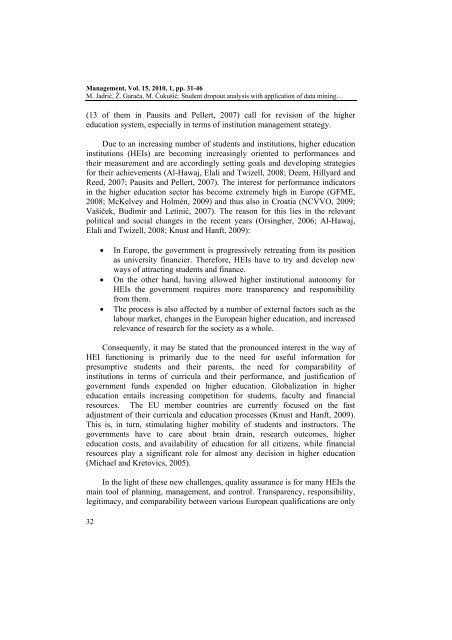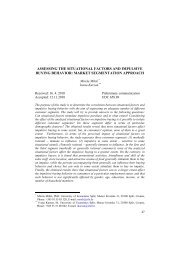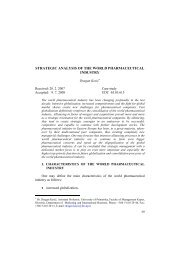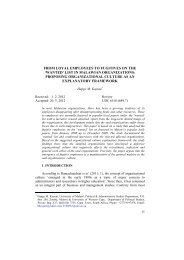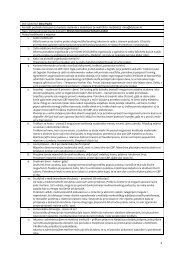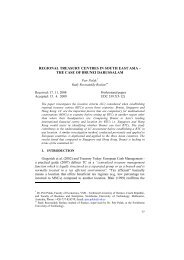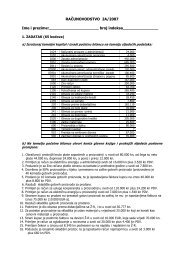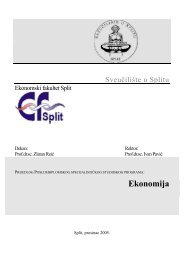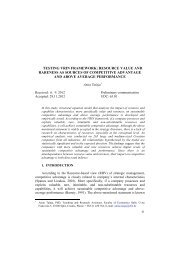student dropout analysis with application of data mining methods
student dropout analysis with application of data mining methods
student dropout analysis with application of data mining methods
You also want an ePaper? Increase the reach of your titles
YUMPU automatically turns print PDFs into web optimized ePapers that Google loves.
Management, Vol. 15, 2010, 1, pp. 31-46<br />
M. Jadrić, Ž. Garača, M. Ćukušić: Student <strong>dropout</strong> <strong>analysis</strong> <strong>with</strong> <strong>application</strong> <strong>of</strong> <strong>data</strong> <strong>mining</strong>…<br />
(13 <strong>of</strong> them in Pausits and Pellert, 2007) call for revision <strong>of</strong> the higher<br />
education system, especially in terms <strong>of</strong> institution management strategy.<br />
Due to an increasing number <strong>of</strong> <strong>student</strong>s and institutions, higher education<br />
institutions (HEIs) are becoming increasingly oriented to performances and<br />
their measurement and are accordingly setting goals and developing strategies<br />
for their achievements (Al-Hawaj, Elali and Twizell, 2008; Deem, Hillyard and<br />
Reed, 2007; Pausits and Pellert, 2007). The interest for performance indicators<br />
in the higher education sector has become extremely high in Europe (GFME,<br />
2008; McKelvey and Holmén, 2009) and thus also in Croatia (NCVVO, 2009;<br />
Vašiček, Budimir and Letinić, 2007). The reason for this lies in the relevant<br />
political and social changes in the recent years (Orsingher, 2006; Al-Hawaj,<br />
Elali and Twizell, 2008; Knust and Hanft, 2009):<br />
32<br />
� In Europe, the government is progressively retreating from its position<br />
as university financier. Therefore, HEIs have to try and develop new<br />
ways <strong>of</strong> attracting <strong>student</strong>s and finance.<br />
� On the other hand, having allowed higher institutional autonomy for<br />
HEIs the government requires more transparency and responsibility<br />
from them.<br />
� The process is also affected by a number <strong>of</strong> external factors such as the<br />
labour market, changes in the European higher education, and increased<br />
relevance <strong>of</strong> research for the society as a whole.<br />
Consequently, it may be stated that the pronounced interest in the way <strong>of</strong><br />
HEI functioning is primarily due to the need for useful information for<br />
presumptive <strong>student</strong>s and their parents, the need for comparability <strong>of</strong><br />
institutions in terms <strong>of</strong> curricula and their performance, and justification <strong>of</strong><br />
government funds expended on higher education. Globalization in higher<br />
education entails increasing competition for <strong>student</strong>s, faculty and financial<br />
resources. The EU member countries are currently focused on the fast<br />
adjustment <strong>of</strong> their curricula and education processes (Knust and Hanft, 2009).<br />
This is, in turn, stimulating higher mobility <strong>of</strong> <strong>student</strong>s and instructors. The<br />
governments have to care about brain drain, research outcomes, higher<br />
education costs, and availability <strong>of</strong> education for all citizens, while financial<br />
resources play a significant role for almost any decision in higher education<br />
(Michael and Kretovics, 2005).<br />
In the light <strong>of</strong> these new challenges, quality assurance is for many HEIs the<br />
main tool <strong>of</strong> planning, management, and control. Transparency, responsibility,<br />
legitimacy, and comparability between various European qualifications are only


